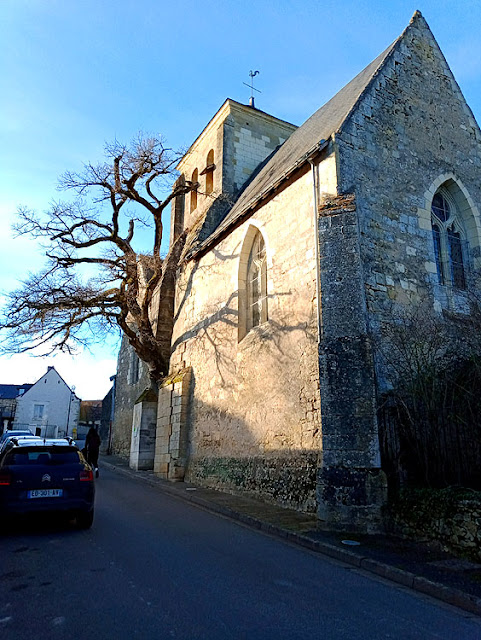On Saturday I deliberately made a small detour in my journey to somewhere else and stopped off in a tiny village crammed higgledy piggledy into a valley between Chinon and Azay le Rideau. The reason was that I knew there was something extraordinary in the village, and I'd never seen it.
It is officially designated 'un arbre remarquable' and the thing that is remarkable about it is not the tree per se but where it is growing.
The tree, a Sessile Oak Quercus petraea (Fr. Chêne sessile) estimated to be around 300 years old, has grown into the wall of the church at Cheillé between two buttresses, and the roots have penetrated very deeply into the thick walls, although not gone all the way through as no trace of the tree is visible on the inside of the church. The trunk emerges from the wall more than a metre above the ground, so the tree is genuinely growing in the wall, not at the base. It has certainly been in the wall of the church and well established since the mid-19th century as local families have handed down their memories of it from one generation to the next.
It is a mystery as to how it got there, or why it wasn't removed as a sapling. One theory is that a European Jay cached an acorn in a crevice, jamming it in hard and allowing it to germinate and ultimately flourish.
At one point the weight of the tree was threatening the structural integrity of the belltower and the agency in charge of historic monuments planned to remove it. The villagers protested and wanted to keep the tree. Nevertheless, the tree has been mutilated on occasions over the years, damaged by roadworks and the installation of telephone lines, which cut through some roots. Nowadays there is a document written by a tree surgeon and member of the French Arboriculture Association which instructs the authorities and relevant agencies on the care of the tree and counsels against radical pruning.
The church is 13th century, with 15th, 16th and 18th century additions. Originally the belltower had a stone spire, but it was destroyed when hit by lightning. The current roof and the brick vaulted ceilings inside the church are 19th century.





5 comments:
It was part of God’s plan. Can we call this symbiosis?
It is surprising where trees will grow. When you wander around the limestone pavements here and see large trees of various types growing in the smallest of cracks in solid limestone. Amazing.
chm: I'm sure there is a clever joke to make there.
Colin and Elizabeth: Yes there is some similarity.
Oaks, pretty much my favorite trees. I end up with dozens every spring from the dropped acorns of the trees on the property. I feel sad removing them! Our property, near Carpentras, left to itself, within a short time would revert to the oak woodland which surrounds it. I can't help but root for the oaks (is that some sort of pun?).
bonnie in Mazan
Bonnie: they certainly are willing germinators.
Post a Comment